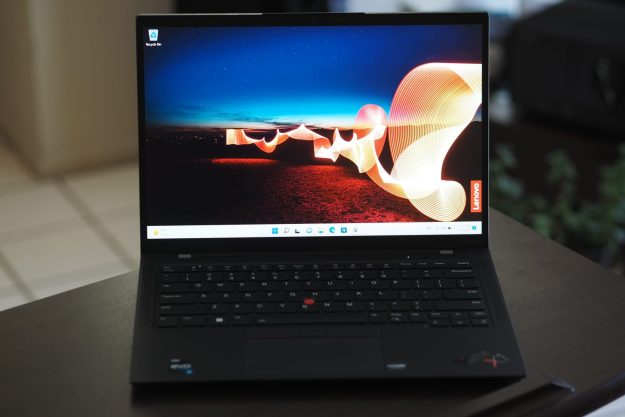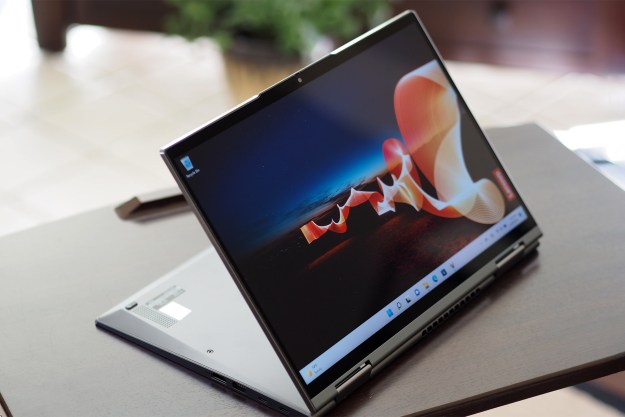Lenovo’s 14-inch ThinkPad X1 line is tailored for performance and portability, and out of the lineup, the X1 Carbon Gen 7 and X1 Yoga Gen 4 stand out. The former is its premier clamshell laptop while the latter is its premier 2-in-1 — and both received some significant updates for their respective generations.
While the ThinkPad X1 Carbon is a refined version of the traditional ThinkPad build and aesthetic, the ThinkPad X1 Yoga represents a significant departure with a metal chassis and standout look. Which is the better example of a modern ThinkPad? Let’s find out.
Design

The ThinkPad X1 Carbon Gen 7 received a serious slimming down this time around, with smaller bezels resulting in an overall smaller chassis and about a millimeter shaved off its thickness. It retains that iconic ThinkPad aesthetic. It’s all-black except for some red accents in the ThinkPad and X1 logos and the red TrackPoint nubbin in the middle of the keyboard.
Only the 4K version of the X1 Carbon has any splash, adding a woven carbon fiber pattern that adds some elegance.
The ThinkPad X1 Yoga Gen 4 underwent an even more significant design overhaul, eschewing the magnesium allow and carbon fiber making up the X1 Carbon and moving instead to an aluminum chassis. It, too, is slimmer and smaller than the previous version, and the gunmetal gray aesthetic is also broken only by the usual ThinkPad red accents.
You’ll have a harder time recognizing the X1 Yoga as a ThinkPad, at least from a distance, but we do like the conservative look. The X1 Yoga feels more robust thanks to its cold, hard metal. Both are solid devices, though.
Because they’ve both been slimmed down, their keyboards are identically less deep than previous generations — specifically, with 15mm of travel compared to the 18mm of travel with older models. ThinkPad aficionados will notice the difference, but any touch typist will be able to get comfortable with these keyboards thanks to their snappy and precise mechanisms.
The TrackPoint and touchpad performance on both are equivalent and excellent, with the touchpads both supporting Microsoft Precision drivers and Windows 10 multitouch gestures. The X1 Yoga wins out in offering a touch display with active pen (included) support, which the X1 Carbon does not.

Another area of similarity is in their display options — both offer Full HD (1,920 x 1,080) or 4K (3,840 x 2,160) panels that offers a wider color gamut, more accuracy, higher brightness, and greater contrast. The latter display offers Dolby Vision high dynamic range (HDR) support. The ThinkPad X1 Carbon and Yoga are the first of Lenovo’s 14-inch ThinkPads to offer a
In addition to Full HD and 4K, Lenovo offers a 1440p (2,560 x 1,440) version of the X1 Carbon Gen 7, but it’s slightly darker than the Full HD version, clocking in with a peak brightness of 300 nits compared to 400 nits on the Full HD display.
Unsurprisingly, both laptops enjoy the same connectivity, with two USB-C ports with Thunderbolt 3 support, an Ethernet/docking station connector (requiring an optional adapter, alas), two USB-A Gen 1 ports, and a full-size HDMI port.
Performance

In what’s becoming a theme for this comparison, both the X1 Carbon and the X1 Yoga offer the same 8th-gen Intel Core processor options (soon to be updated to Intel’s 10th-gen parts). In our testing, the laptops performed within a few percentage points of each other. One might be tempted to suspect that these are the same machines inside, with the X1 Yoga merely offering a 360-degree hinge and some extra components for touch and pen input support.
The bottom line is that both laptops are plenty speedy for productivity work, and you can get a boost of power beyond the admittedly average speed by selecting “Performance” mode on the Windows 10 power slider.
That gives you a very real choice between quiet and cool operation and higher performance — and we do like that Lenovo built that into the Windows utility rather than requiring a separate utility as do vendors like HP and Dell.
Portability

The X1 Carbon and X1 Yoga are also similarly sized in width and depth with small side bezels but rather bezels along the top and bottom, and they’re both 0.59 inches thick. The X1 Carbon is lighter than the X1 Yoga, at 2.4 pounds versus 2.99 pounds, thanks to the latter’s heavier metal chassis. But, neither will weigh you down.
And, you’ll be shocked to hear that in our testing, the 4K models also showed roughly equivalent battery life with equal 51 watt-hour batteries in both. That is, neither is likely to get you through a full working day away from a charge. We tested the X1 Yoga with a Core i5 and a low-power Full HD display, and it roughly doubled the battery life, and the X1 Carbon with the same display can be expected to perform equally well.
The X1 Yoga stands out

Each of these laptops is a mid range laptop. The ThinkPad X1 Carbon Gen 7 starts off at a base price of $1,109 ($800 on clearance) for a Core i5-8265U CPU, 8GB of RAM, a 256GB PCIe SSD, and a non-touch Full HD screen. If you have the budget for it, you can shell out as much as $3,469 ($1,200 on sale) for a Core i7-8665U CPU, 16GB of RAM, a 1TB PCIe SSD and a non-touch 4K display.
The ThinkPad X1 Yoga is a little on the pricier side compared to the ThinkPad X1 Carbon Gen 7, but several of the configurations provide 10th-gen Intel processors. The initial design begins at a sale price of $1,749 ($950 on clearance) for a Core i5-10210U, 8GB of RAM, a 256GB PCIe SSD, and a Full HD touchscreen display. Configurations usually cost a maximum of $3,400 ($1,903 on sale) for a Core i7-10510U, 16GB of
Both of these impressive laptops function admirably and have excellent design qualities, and display alternatives. Still, the ThinkPad X1 Yoga is a more contemporary, modernized design that handles better. And not only that, but it also allows for additional 2-in-1 functionality.
Editors' Recommendations
- Best Lenovo laptop deals: Save on Yoga and ThinkPad laptops
- 7 best 2-in-1 laptops in 2024: tested and reviewed
- The best laptops for kids, tested and selected by experts
- This tiny ThinkPad can’t quite keep up with the MacBook Air M2
- Why the Dell XPS 13 Plus still beats the latest competition in little laptops


